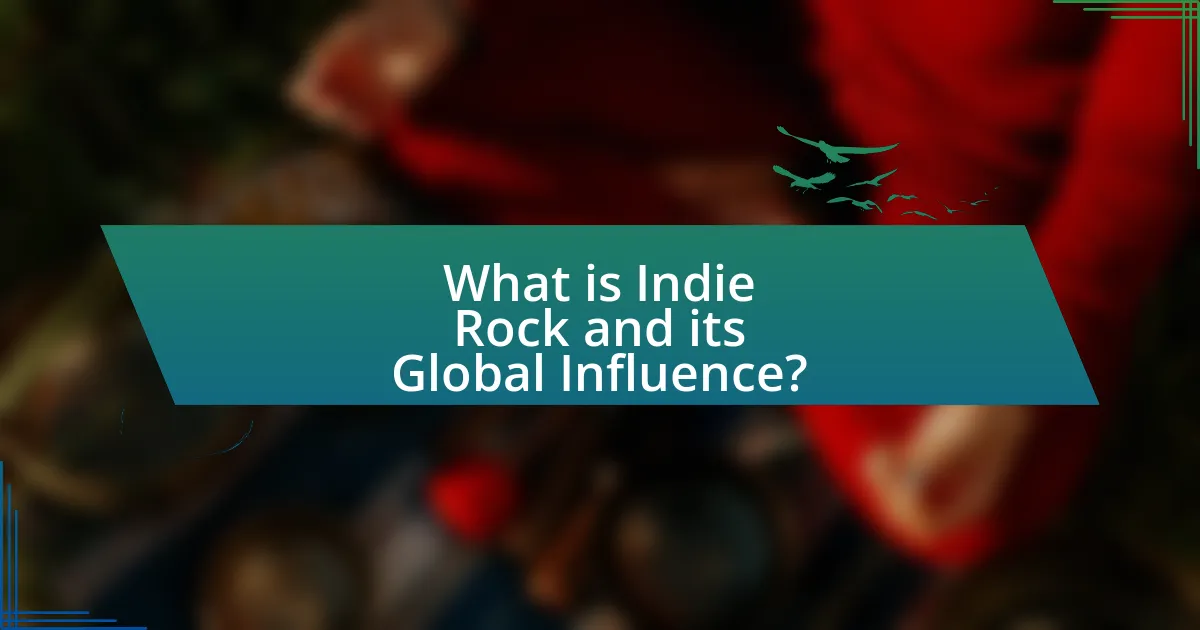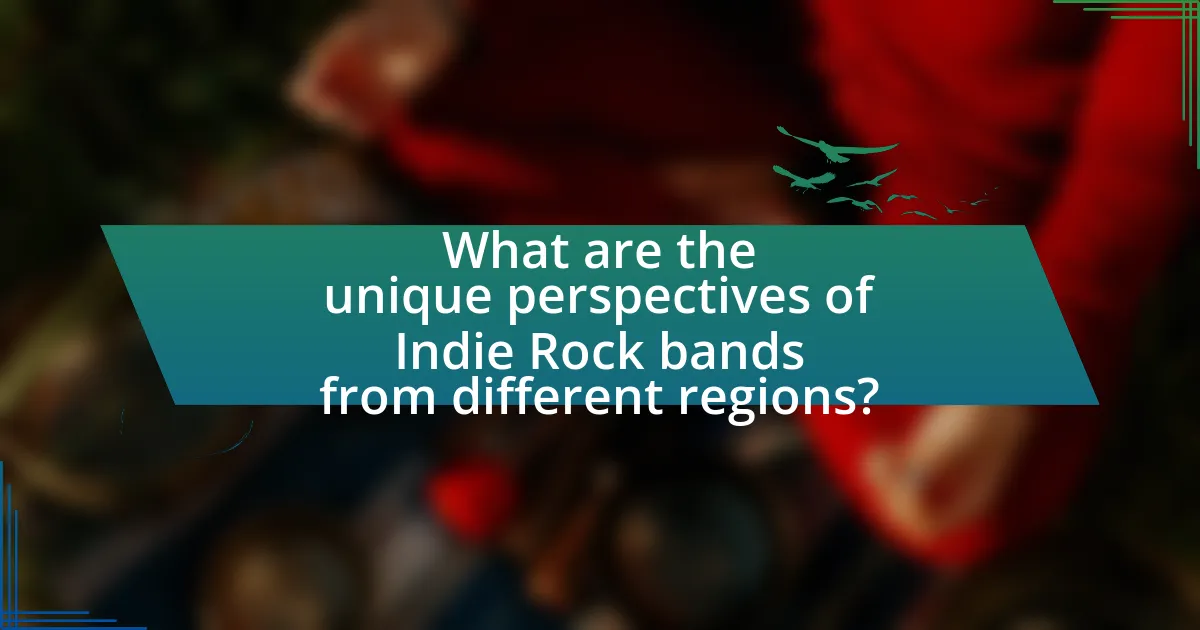Indie rock is a genre of alternative rock music that emerged in the 1980s, characterized by independent production and distribution outside major record labels. This article explores the global influence of indie rock, detailing its origins, evolution, and key characteristics, as well as its significance in the contemporary music scene. It examines how regional influences shape the sound of indie rock bands, highlights notable artists from various countries, and discusses the challenges they face. Additionally, the article delves into the personal experiences of musicians, their creative processes, and how fans can engage with and support their favorite indie rock bands through interviews and social media interactions.

What is Indie Rock and its Global Influence?
Indie rock is a genre of alternative rock music that emerged in the 1980s, characterized by its independent production and distribution, often outside of major record labels. This genre has significantly influenced global music culture by promoting diverse sounds and fostering a DIY ethic among artists. For instance, bands like Radiohead and Arctic Monkeys have achieved international acclaim while maintaining their independent roots, showcasing the genre’s ability to resonate across different cultures. Additionally, indie rock has inspired local music scenes worldwide, leading to the emergence of various sub-genres and styles, such as lo-fi, post-rock, and indie pop, which reflect regional influences and contribute to a rich global tapestry of music.
How did Indie Rock originate and evolve globally?
Indie Rock originated in the 1980s as a response to the mainstream music industry’s commercialization, primarily in the United States and the United Kingdom. The genre evolved from the DIY ethos of punk rock, where independent labels and artists sought creative freedom and authenticity, leading to the emergence of bands like R.E.M. and The Smiths.
As the 1990s progressed, Indie Rock gained global traction, with bands from various countries adopting its principles. For instance, the rise of the Internet in the late 1990s and early 2000s facilitated the distribution of music, allowing international acts like The Strokes from New York and Arctic Monkeys from the UK to gain worldwide recognition.
By the 2010s, Indie Rock had diversified, incorporating elements from various genres and cultures, leading to a rich tapestry of sounds across the globe. This evolution is evidenced by the emergence of bands from non-Western countries, such as Tame Impala from Australia and the rise of indie scenes in places like Japan and Brazil, showcasing the genre’s adaptability and widespread appeal.
What are the key characteristics that define Indie Rock music?
Indie Rock music is characterized by its independent production, diverse sound, and a focus on artistic expression over commercial success. This genre often features unconventional song structures, a blend of various musical influences, and a DIY ethos that emphasizes self-released albums and grassroots promotion. Historically, bands like R.E.M. and The Smiths exemplified these traits in the 1980s, paving the way for a wide range of artists who prioritize authenticity and innovation in their music.
How has the definition of Indie Rock changed over time?
The definition of Indie Rock has evolved from its origins in the 1980s as a term primarily describing independent music labels and their artists to a broader genre that encompasses a diverse range of sounds and styles. Initially, Indie Rock was characterized by its DIY ethos and a rejection of mainstream commercialism, with bands like R.E.M. and The Smiths leading the way. Over time, particularly in the 2000s, the genre expanded to include a variety of influences, incorporating elements from pop, electronic, and even hip-hop, as seen in the works of artists like Arcade Fire and Vampire Weekend. This shift reflects a growing acceptance and blending of genres, as well as the impact of digital distribution, which has allowed for greater accessibility and exposure for independent artists globally.
Why is Indie Rock significant in the global music scene?
Indie Rock is significant in the global music scene because it fosters artistic freedom and diversity, allowing musicians to explore unique sounds and themes outside mainstream commercial constraints. This genre has produced influential bands like Radiohead and Arctic Monkeys, which have shaped musical trends and inspired countless artists worldwide. Additionally, the rise of digital platforms has enabled indie bands to reach international audiences, exemplified by the success of acts like Tame Impala and Bon Iver, who have gained substantial followings across various countries. The global impact of Indie Rock is further evidenced by its presence in major music festivals, such as Coachella and Glastonbury, where indie acts often headline, showcasing their significance in contemporary music culture.
What cultural impacts has Indie Rock had in various countries?
Indie Rock has significantly influenced cultural movements in various countries by promoting artistic independence and diverse musical expressions. In the United States, the genre has fostered a DIY ethic that encourages musicians to produce and distribute their work independently, leading to a flourishing underground scene. In the UK, Indie Rock has shaped youth subcultures, particularly in cities like Manchester and London, where bands like Oasis and Arctic Monkeys have become emblematic of working-class identity and social commentary. In Australia, the genre has contributed to a distinct national sound, with bands like Tame Impala and Courtney Barnett gaining international recognition, thus influencing local music festivals and cultural events. In Japan, Indie Rock has merged with traditional sounds, creating unique fusions that reflect the country’s cultural heritage, as seen in the rise of bands like The Pillows. These examples illustrate how Indie Rock serves as a catalyst for cultural expression and social change across different regions.
How does Indie Rock foster community and connection among fans worldwide?
Indie Rock fosters community and connection among fans worldwide through its emphasis on grassroots movements, local scenes, and shared experiences at live events. This genre often prioritizes authenticity and relatability, allowing fans to feel a personal connection to the music and the artists. For example, many Indie Rock bands engage directly with their audiences via social media platforms, creating a sense of belonging and shared identity among fans across different countries. Additionally, the rise of independent music festivals and local shows facilitates in-person interactions, further strengthening these connections. Research indicates that fans often form lasting friendships and networks through their shared love for Indie Rock, highlighting the genre’s role in building global communities.

What are the unique perspectives of Indie Rock bands from different regions?
Indie Rock bands from different regions offer unique perspectives shaped by their cultural, social, and political environments. For instance, bands from the Pacific Northwest in the United States often emphasize themes of nature and introspection, reflecting the region’s lush landscapes and a history of alternative culture. In contrast, UK Indie Rock bands frequently incorporate elements of irony and social commentary, influenced by the country’s rich musical heritage and socio-political issues.
Additionally, bands from Latin America may blend traditional sounds with modern Indie Rock, showcasing their diverse cultural backgrounds and addressing local social issues through their lyrics. This regional diversity in perspectives is evident in the varying musical styles, lyrical themes, and performance aesthetics, which are all influenced by local traditions and contemporary societal challenges.
How do regional influences shape the sound of Indie Rock bands?
Regional influences shape the sound of Indie Rock bands by integrating local musical traditions, cultural narratives, and social contexts into their music. For instance, bands from the Pacific Northwest often incorporate elements of grunge and folk, reflecting the area’s history and natural landscape, while artists from the UK may draw on post-punk and Britpop influences, showcasing their unique cultural heritage. Additionally, regional themes in lyrics and instrumentation can resonate with local audiences, creating a distinct sound that reflects the band’s environment. This phenomenon is evident in the diverse styles emerging from cities like Austin, known for its vibrant live music scene, which fosters a blend of country, blues, and rock influences, thereby enriching the Indie Rock genre.
What are some notable Indie Rock bands from North America?
Notable Indie Rock bands from North America include Arcade Fire, The National, and Death Cab for Cutie. Arcade Fire, formed in Montreal in 2001, gained critical acclaim with their debut album “Funeral,” which was nominated for a Grammy Award. The National, originating from Cincinnati, Ohio, is known for their atmospheric sound and has received multiple Grammy nominations, particularly for their album “Boxer.” Death Cab for Cutie, formed in Bellingham, Washington, achieved mainstream success with their album “Plans,” which was certified platinum and nominated for a Grammy. These bands exemplify the diversity and influence of the Indie Rock genre in North America.
How do European Indie Rock bands differ in style and themes?
European Indie Rock bands differ in style and themes primarily through their incorporation of diverse cultural influences and regional issues. For instance, bands from the UK often blend traditional British rock elements with modern sounds, while Scandinavian groups frequently integrate folk music and electronic influences, reflecting their unique cultural heritage. Additionally, themes in European Indie Rock often address social and political issues relevant to their specific countries, such as immigration in France or environmental concerns in Germany. This regional specificity in both style and thematic content highlights the varied landscape of European Indie Rock, showcasing how local contexts shape musical expression.
What challenges do Indie Rock bands face in their respective regions?
Indie Rock bands face several challenges in their respective regions, including limited access to funding, competition from mainstream music, and difficulties in securing performance venues. For instance, many Indie Rock bands struggle to find financial support due to a lack of sponsorship and investment opportunities, which is crucial for recording and touring. Additionally, the saturation of the music market with mainstream artists often makes it hard for Indie bands to gain visibility and attract audiences. Furthermore, in various regions, securing venues for live performances can be problematic due to high rental costs or a lack of interest from venue owners in hosting Indie acts. These challenges collectively hinder the growth and sustainability of Indie Rock bands in their local music scenes.
How do economic factors affect the Indie Rock scene in different countries?
Economic factors significantly influence the Indie Rock scene in different countries by affecting funding, audience size, and market accessibility. For instance, in countries with strong economies, such as the United States and the United Kingdom, bands often have better access to resources like recording studios, marketing, and touring opportunities, which can lead to greater visibility and success. Conversely, in nations with weaker economies, such as some Eastern European countries, limited financial resources can hinder the ability of bands to produce music, promote themselves, and reach wider audiences. Additionally, economic stability can impact ticket prices and venue availability, directly affecting live performances, which are crucial for Indie Rock artists. According to a 2021 report by the International Federation of the Phonographic Industry, markets with higher disposable income tend to have more vibrant music scenes, supporting the idea that economic conditions directly correlate with the health of the Indie Rock genre in various regions.
What role does government support play in the success of Indie Rock bands?
Government support plays a crucial role in the success of Indie Rock bands by providing financial assistance, resources, and promotional opportunities. This support can manifest through grants, subsidies, and funding for music festivals, which help emerging artists gain visibility and access to larger audiences. For instance, countries like Canada have established programs such as the Canada Music Fund, which allocates millions annually to support the development of Canadian artists, including Indie Rock bands. This financial backing enables bands to produce high-quality recordings, tour, and market their music effectively, ultimately enhancing their chances of success in a competitive industry.

How do interviews with Indie Rock bands reveal their stories and experiences?
Interviews with Indie Rock bands reveal their stories and experiences by providing firsthand accounts of their creative processes, personal struggles, and cultural influences. These interviews often delve into the band’s formation, musical inspirations, and the challenges they face in the music industry, allowing listeners to connect with their narratives on a deeper level. For instance, a study by the University of California found that artists who share their personal stories in interviews foster a stronger emotional connection with their audience, enhancing the listener’s understanding of the band’s journey and artistic vision.
What common themes emerge from interviews with Indie Rock musicians?
Common themes that emerge from interviews with Indie Rock musicians include the importance of authenticity, the influence of personal experiences, and the desire for creative freedom. Musicians often emphasize the need to stay true to their artistic vision, reflecting a commitment to genuine expression rather than commercial success. Additionally, many artists draw inspiration from their life stories, societal issues, and cultural backgrounds, which shape their music and lyrics. The pursuit of creative freedom is also a prevalent theme, as musicians frequently discuss the challenges of navigating industry pressures while maintaining their unique sound and identity. These insights are supported by various interviews and articles that highlight the shared values and experiences within the Indie Rock community.
How do personal experiences influence the songwriting of Indie Rock bands?
Personal experiences significantly influence the songwriting of Indie Rock bands by providing authentic emotional content and relatable narratives. Many Indie Rock artists draw from their own life events, relationships, and struggles, which allows them to create songs that resonate deeply with listeners. For instance, bands like Death Cab for Cutie often incorporate themes of heartbreak and nostalgia, reflecting lead singer Ben Gibbard’s personal experiences. This connection to real-life situations not only enhances the emotional depth of their music but also fosters a sense of community among fans who may share similar experiences. The authenticity derived from personal storytelling is a hallmark of the Indie Rock genre, making it distinct and impactful.
What insights do bands share about their creative processes?
Bands often share that their creative processes involve collaboration, experimentation, and drawing inspiration from diverse influences. For instance, many bands emphasize the importance of group dynamics, where each member contributes unique ideas, leading to a richer sound. Additionally, bands frequently mention the role of improvisation during jam sessions, which can spark new musical directions. Research indicates that collaborative songwriting can enhance creativity, as seen in studies highlighting the benefits of collective brainstorming in music creation. This collaborative approach not only fosters innovation but also strengthens the bonds between band members, ultimately shaping their artistic identity.
How can fans engage with Indie Rock bands through interviews?
Fans can engage with Indie Rock bands through interviews by participating in Q&A sessions, submitting questions via social media, and attending live interview events. These interactions allow fans to express their curiosity and connect with the artists on a personal level. For instance, platforms like Instagram and Twitter often host live sessions where fans can ask questions directly, fostering a sense of community and involvement. Additionally, many bands conduct interviews with fan-submitted questions, which can be featured in podcasts or video formats, further enhancing fan engagement. This method not only provides fans with insights into the band’s creative process but also strengthens the bond between the artists and their audience.
What platforms are best for discovering interviews with Indie Rock artists?
YouTube is one of the best platforms for discovering interviews with Indie Rock artists, as it hosts a vast array of video content including artist interviews, live performances, and behind-the-scenes footage. Additionally, platforms like Spotify and Apple Music often feature exclusive interviews and podcasts related to Indie Rock, providing insights directly from the artists. Websites such as Pitchfork and NME also publish written interviews and articles that delve into the Indie Rock scene, offering context and commentary on the genre. These platforms collectively provide a comprehensive view of Indie Rock artists through various formats, ensuring fans have access to diverse content.
How can fans support their favorite Indie Rock bands based on interview insights?
Fans can support their favorite Indie Rock bands by attending live shows, purchasing merchandise, and engaging with the bands on social media. Attending live performances directly contributes to the band’s revenue and helps build a loyal fan base. Purchasing merchandise not only provides financial support but also promotes the band’s brand. Engaging with bands on social media fosters a community and increases visibility, as bands often rely on word-of-mouth and online interactions to reach new audiences. These insights are commonly shared by Indie Rock bands during interviews, highlighting the importance of fan involvement in their success.



